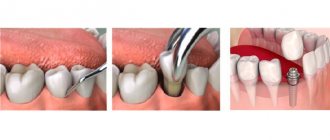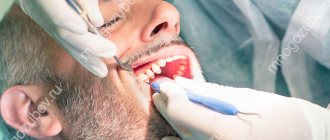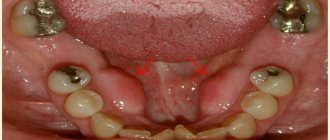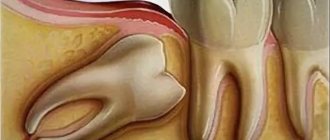Implantation is the installation of artificial tooth roots into the jaw, onto which crowns are separately fixed. It is carried out to restore the chewing function of a lost tooth. Several implantation protocols have been developed in dentistry. The classic one is carried out in two stages and involves a break between implantation and prosthetics - more reliable, but longer. With a one-stage crown, crowns are installed immediately - faster, but there are a number of requirements for the condition of the bone tissue. A one-stage procedure is carried out immediately after tooth extraction, the implant is installed in the hole - there is no need to wait until the bone is restored. Each method has its own advantages and disadvantages.
Comparison of techniques
| Classical | One-stage | One-step | |
| Implant installation method | Flap - with peeling of the gum to access the bone | Transgingivally - through a puncture of soft and bone tissues | In the socket of an extracted tooth |
| Type of temporary prosthetics | A removable denture that is fixed to adjacent teeth | Temporary lightweight crown on an implant with bite relief | Removable denture or temporary crown on an implant |
| Duration of temporary prosthetics | 2-6 months before implant implantation | 2-6 months before implant implantation | 2-6 months before implant implantation |
| Formation of the gingival contour | Before permanent prosthetics | Not carried out | Depends on the type of prosthetics |
| Type of permanent prosthetics | Zirconium dioxide crown | Zirconium dioxide crown | Zirconium dioxide crown |
All three methods are painless, are performed under local anesthesia or sedation, and the patient does not feel any discomfort.
The same preparation is carried out, there is no difference in the required examinations. To identify contraindications, the following is carried out:
- taking anamnesis;
- inspection;
- CT scan.
The contraindications are the same:
- uncompensated diabetes mellitus;
- oncology;
- osteoporosis;
- bleeding disorders;
- tuberculosis;
- mental disorders.
But patients are more interested in the ability to quickly recover a lost tooth completely. According to this criterion, two methods differ - classical and one-stage. The one-stage method after removal is continued according to one of the protocols - with delayed or immediate loading.
Indications and contraindications for implantation immediately after tooth extraction
More recently, orthopedic dentists believed that it was undesirable to combine tooth extraction and the introduction of a titanium root into the bone in one operation, since such a complex intervention is associated with high risks. Modern protocols, technologies and equipment allow for simultaneous implantation, which has its own advantages. Indications for installing an implant immediately after tooth extraction:
- tooth injury associated with its non-viability;
- root fracture;
- destruction of the tooth crown that is not amenable to therapeutic treatment.
But there are a fairly large number of restrictions for instant implantation. Among them:
- the presence of inflammation in the area of the tooth to be removed;
- insufficient volume of bone tissue: an implant simply will not take root without a preliminary procedure for increasing the volume;
- diseases requiring dental treatment (periodontal disease with destruction of gum tissue, caries, etc.).
The above contraindications also include general restrictions for implantation. These are diabetes mellitus and blood diseases, cancer pathologies, mental illnesses, immunodeficiencies, pregnancy and some other conditions. The choice of implantation method is chosen by the doctor, focusing on the clinical situation, examination data and the patient’s wishes.
The success of the entire procedure is greatly influenced by the surgeon’s professionalism, experience and skills. It is necessary that the tooth extraction operation be carried out efficiently, carefully and with the minimum possible trauma.
Doctor's advice: an implant can only be installed if the bone size is sufficient.
In all cases, the parameters of bone tissue are taken into account - density, height, width. Only when there is sufficient bone size can an implant be installed with a selected size and shape that can cope with chewing loads in the future. If there is not enough bone tissue, it is impossible to install the “correct” implant.
Levin Dmitry Valerievich
Chief physician, Ph.D.
If the bone dimensions do not correspond to the norm, preliminary osteoplasty is required, followed by installation of an implant according to the classical protocol. If the deficiency is small, a one-step bone augmentation and implant installation is possible.
A high-quality one-stage technique cannot be carried out in conditions of insufficient bone tissue. And it is also impossible to carry out bone augmentation at the same time - the operation is performed through a puncture, the doctor does not have access to the bone, he places the implant blindly.
In addition, with a one-stage protocol, the implant is immediately loaded with a temporary crown, which does not completely compensate for chewing functions. The implant cannot be actively used to avoid displacement. Full load is possible only after engraftment of the titanium root after 2-6 months, as with the classical method.
Complete restoration of chewing ability is no different for the classic and one-stage protocols. One-stage allows you to quickly hide an aesthetic defect, which is only relevant for the front teeth.
Classic implantation lasts longer, especially if the bone is previously built up. But the method is reliable and designed for long-term results:
- an implant of the correct shape and size is selected;
- before engraftment, it is sutured, overgrown with bone tissue, and not loaded—the risk of displacement during chewing is eliminated;
- during installation, the doctor sees the area of the operation and can perform manipulations to adapt the bone to future loads - this is impossible with immediate loading.
Make an appointment with an implantologist
About the procedure.
There are many different names for this implantation method: one-stage, express, seamless, etc. All these concepts fully reflect the essence of this technology. Those who have at least once encountered the problem of missing teeth know that there are several options for restoring them; one of the most common is removable dentures. For patients who strive to achieve maximum naturalness, this method is not entirely suitable. Such prostheses are unreliable; on average, their service life is 7-10 years, and after that they have to be replaced and again spend money. In addition, removable artificial teeth can cause discomfort and require careful care.
It is for these reasons that most patients choose to install implants. These are structures made of titanium that are implanted into the jawbone, in the place where the lost tooth used to be. They become firmly stabilized and eventually fuse with the bone tissue, a process called osseointegration. After this, the prosthesis is fixed to the implant; patients often choose crowns. Such artificial teeth exactly repeat the anatomical features of living ones, they can withstand any load, and with proper care they will last you a lifetime. Agree, it is better to install an implant once than to constantly replace old removable dentures with new ones.
The need to restore teeth in a short time prompted specialists to create a new method of dental implantation, which makes it possible to insert an implant and fix a temporary crown in 1 day. It was invented in the 90s of the 20th century, and is still successfully used by orthopedic dentists. After the operation, the patient can continue to live his normal life, the risks of complications are reduced to zero. Dental implantation in one day in Moscow at the A-medic clinic is carried out by highly qualified specialists with more than 10 years of experience. A special difference between this technique and traditional dental implantation is that a temporary crown is immediately fixed onto the implanted implant. After an adaptation period, when the titanium screw successfully fuses with the bone tissue, this prosthesis is replaced with a permanent one. In the case of the classic version of the operation, before installing a crown, the patient has to wait 4-6 months until the implant osseointegrates.
Features of the rehabilitation period
To eliminate pain during the first 2-3 days after surgery, experts recommend using painkillers. The patient may also be prescribed anti-inflammatory and antibacterial drugs to prevent the occurrence of the inflammatory process. For the first time after implantation, it is advisable to consume only soft and liquid foods. In the future, it is necessary to ensure proper oral care, which will prevent the development of serious diseases.
Contraindications
Restrictions can be absolute or relative. The following are absolute:
- Diseases of the circulatory system.
- Psychical deviations.
- Malignant tumors.
- Connective tissue diseases.
- Poor immunity.
- Tuberculosis, complications after illness.
- Inflammatory diseases of the oral mucosa.
- Diabetes.
- High tone of the muscles responsible for the chewing process, bruxism.
- Venereal diseases, AIDS.
- Allergy to anesthetic drugs.
- Diseases of bone tissue.
- Endocrine pathologies.
In case of absolute contraindications, express implantation cannot be performed. There are also relative contraindications, which include:
- Untreated caries.
- Poor oral hygiene.
- Inflammatory pathologies of the gums.
- Periodontitis.
- Arthrosis in the jaw area.
- Malocclusion.
- Atrophic processes in bone tissue on the alveolar processes.
- Drug and alcohol addiction, smoking.
- Pregnancy period.
Remember that smoking and implantation are difficult to compatible things. Smokers have a fairly high risk of denture rejection. Two weeks before the procedure you should give up cigarettes.
General restrictions for the procedure include:
- Allergic reactions to painkillers.
- General somatic pathologies (surgery can provoke an exacerbation of pathologies).
- Taking certain medications.
- Mental illnesses.
- Prolonged stress conditions.
- General exhaustion of the body, for example, after a serious illness.
- Insufficient oral care.
There are also local contraindications:
- Atrophic processes in bone tissue at the site of implant installation.
- Insufficient hygienic care of teeth and gums.
- A short distance to the maxillary and nasal sinuses.
There are also time restrictions:
- Any pathology in the acute stage.
- Recovery after illness.
- Bearing the fetus.
- Recovery after radiation therapy.
- Drug and alcohol addiction.
If the prosthesis is installed correctly and all possible risks and limitations are assessed, the operation will be effective and completely safe. That is why it is recommended to undergo a full medical examination before starting the procedure.
Comparison of classical and express implantation
In the table below we compare classic two-stage implantation and one-stage surgery according to basic criteria:
| Comparison criterion | Classical | Express implantation |
| How long should it take after tooth extraction? | depending on the rate of bone tissue recovery | the operation can be performed immediately after the unit is removed |
| What preliminary procedures are required? | most often it is necessary to perform bone grafting | in most cases there is no need for bone augmentation |
| How many operations are required? | at least two (with a long break) | usually two operations (with a break of 2-3 days) or one |
| When is prosthetics performed? | 3-8 months after dental implantation | simultaneously with the installation of a titanium rod or after 2-3 days |
| How long is the recovery period after implantation? | pain, swelling and bleeding continue for 3-5 days after the procedure | mild pain and swelling disappear within 2-3 days after surgery |
Stages of one-stage implantation
Fear of the dentist is a fairly common problem, despite the fact that modern methods and materials can significantly reduce pain during treatment. The worries will not be so strong if you initially know all the stages of the procedure and see that there is nothing to fear:
- Before the operation, a consultation is always carried out with a detailed diagnosis of the patient’s condition.
- A CT scan of the jaw is performed.
- A decision is made on the advisability of the operation.
- The doctor makes a 3D simulation of the operation.
- The patient is given local anesthesia.
- Complete removal of the deformed tooth is performed;
- Using a special drill, a hole is drilled in the bone tissue of the jaw.
- The hole is expanded to the optimal diameter with a special tool.
- The implant is implanted through the root socket: the element is screwed into the jaw.
- Next, the abutment is fixed to the implant.
- A temporary composite crown is installed.
A temporary crown should be worn until the implant is completely healed. On average no more than six months. Then a permanent crown is installed from durable, abrasion-resistant materials: metal ceramics or zirconium dioxide.
Advantages of the 1-day dental implantation method.
Very often, patients are faced with the choice of installing removable dentures or restoring teeth using implantation. Each method has its advantages and disadvantages, but today the technology of implantation is considered one of the most modern, durable and safe. Such artificial teeth will serve you for several decades; they can withstand the chewing load perfectly and prevent the process of bone tissue atrophy.
Why choose dental implantation in one day:
- Restoring teeth in a short time.
- Minimal risks of complications.
- Excellent aesthetic result.
- This implantation method can be carried out immediately after the tooth extraction procedure.
- Implantation of the implant and installation of the abutment is carried out in one stage.
If you postpone the restoration of missing teeth for a long time, neighboring units of the dentition will begin to shift towards the defect. They may take an incorrect position, causing the bite to change. Subsequently, you will have to deal with not only orthopedic treatment, but also orthodontic treatment. The A-medic clinic in Moscow offers all its patients not to skimp on their health and take advantage of a unique technology, dental implantation in one day. The price of such a procedure will depend on the number of units being restored. To find out the exact cost, you can sign up for an initial consultation and discuss all your questions with a qualified specialist.
Disadvantages of classical dental restoration
A beautiful smile is an important part of any person’s image, but it is impossible without healthy teeth. In cases where a tooth has been lost due to disease or injury or needs to be removed, patients are given an artificial prosthesis instead. Until recently, implantation took a long time and took place in several stages:
- Preparation of dental tissue. Required in cases where the bone tissue is too weak or not enough to fix the implant. The problem is solved by increasing the required amount of tissue artificially. If it is sufficient to install the prosthesis, this stage is eliminated.
- Securing the implant. 5 months after building up the dental tissue, an implant is attached to the place where a tooth (or several) is missing. Its role is most often played by a screw made of durable metal. It takes 4 months for a screw to grow into the lower jaw, and 6 months for the upper jaw.
- Installation of prostheses. The final stage of implantation, during which a dental crown is placed on the ingrown implants. It is made from special materials that accurately imitate real teeth, tailored to individual sizes and fixed with dental cement.
Classic scheme
During the intermediate stages, patients experience a lot of physiological and aesthetic inconveniences and seriously adjust their diet, excluding solid foods. A new restoration technique—simultaneous dental implantation—allowed us to solve these problems.
One-step scheme (express)
Single-stage implantation: what is it?
Instant prosthetics involves installing an implant immediately after removing a damaged tooth. This method is considered the most gentle and is recommended by doctors for those patients who do not have serious contraindications.
A thorough examination of the oral cavity should be done in advance, and if sanitation is indicated, the doctor will perform it before surgery.











